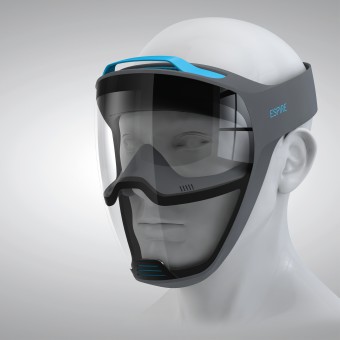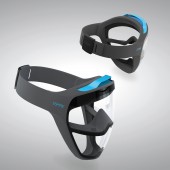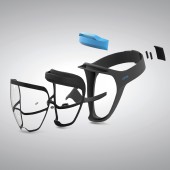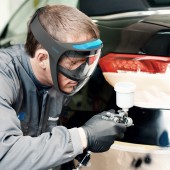Espire Full Face Gas Mask by Carlos Schreib |
Home > Winners > #50042 |
 |
|
||||
| DESIGN DETAILS | |||||
| DESIGN NAME: Espire PRIMARY FUNCTION: Full Face Gas Mask INSPIRATION: Full face gas masks are unchanged in their component arrangement for decades. They consist of a small visor, an inner mask and an outer mask to keep exhaled air from the visor to prevent fogging. Both the filter and the outlet valve are always at the bottom of the mask. My research with professional painters and varnishers made clear, that no user actually likes to wear a gas mask, also because the product has negative connotations. Changing this was my Inspiration. UNIQUE PROPERTIES / PROJECT DESCRIPTION: ESPIRE moved the filter to the top of the mask and thereby enabled a fully transparent mouth section. The air flow is now guided in a linear stream from the top of the mask to the outlet valve located at the chin. A separator between viewing and mouth area ensures fog free vision. With this arrangement the air flow is not only optimized but the aesthetics and the archetype of a respirator are completely changed and communication ability is drastically increased. OPERATION / FLOW / INTERACTION: Apart from optimizing the airflow, Espire focuses on easy usability. Unlike the usual masks with many straps that need to be adjusted every time, Espire uses a single but wide strap that only needs to be adjusted once. After that, the flexible grey material can be stretched and then the whole mask is pulled over the head and face. Sports utilites like snowboard masks have been an inspiration here. The filter exchange is also improved, as it can be easily changed with two fingers only. The flexible material around the filter bends into the opening and seals it, while the filter is being inserted. No screws or anything is needed for its fixation. PROJECT DURATION AND LOCATION: The project started in October 2014 in Berlin and was finished at the end of February 2016 with a total duration of about 3,5 months. |
PRODUCTION / REALIZATION TECHNOLOGY: EPDM (Rubber) Material is used for the grey flexible parts to ensure a tight fit on a great variety of faces. The polycarbonate visor for clear vision that can be cleaned easily and doesn't break. SPECIFICATIONS / TECHNICAL PROPERTIES: 300 mm x 300 mm x 300 mm TAGS: Tools, Work Place, Safety, Capital Goods, Usablity Improvement, Innovation RESEARCH ABSTRACT: The research included many interviews with professional users of gas masks and analysis of their behaviour. Many users avoid using them whilst working, which is a real health risk. The aversion comes from the small viewing area, the bulkiness that causes strain after long use, and the poor usability when adjusting the unwieldly straps. I analysed the components of other masks. The air comes from the bottom of the filter, only to be sucked into the viewing area to “wash” the visor with fresh air to keep it free from fog. Afterwards, the air gets sucked through a small valve into the inner mask where it gets inhaled and then exhaled through a valve at the chin. My question was, if the air first interacts at the visor, which is at the top of the mask, why does it come from the bottom? Sketches were used to approach an idea and a visual language, 3D-printed mock ups and rubber materials simulated different variations of geometry, functionality and form. CHALLENGE: The hardest part of the development was to find a new idea on how to motivate the users to use gas masks more often and provide the same functionality as the usual gas masks at the same time. ADDED DATE: 2016-08-28 23:35:32 TEAM MEMBERS (1) : Carlos Schreib IMAGE CREDITS: All Images and Photos: Carlos Schreib PATENTS/COPYRIGHTS: Patent DE102015107175 |
||||
| Visit the following page to learn more: http://www.carlos-schreib.com/espire | |||||
| AWARD DETAILS | |
 |
Espire Full Face Gas Mask by Carlos Schreib is Winner in Safety Clothing and Personal Protective Equipment Design Category, 2016 - 2017.· Read the interview with designer Carlos Schreib for design Espire here.· Press Members: Login or Register to request an exclusive interview with Carlos Schreib. · Click here to register inorder to view the profile and other works by Carlos Schreib. |
| SOCIAL |
| + Add to Likes / Favorites | Send to My Email | Comment | Testimonials | View Press-Release | Press Kit |
Did you like Carlos Schreib's Protective Equipment Design?
You will most likely enjoy other award winning protective equipment design as well.
Click here to view more Award Winning Protective Equipment Design.








